Fantastic Fisheye Lens Photography: A Basic Guide
Fisheye lens photography is a genre that depends completely on one thing: the extreme panoramic perspective created by the fisheye lens.
These lenses are wild beasts in the world of camera lenses, due to their huge field of view and strong visual distortions.
Some people love them, some hate them. Some consider them to be toy lenses, with no real use other than creating funny and weird-looking portraits. And others see them as a way to make a statement through a distorted but eye-catching image.

In reality, fisheye lenses are much more than curiosities. They are a very particular tool that can produce powerful effects in the hands of a skilled photographer.
This article is all about how to master your fisheye lens so that you can create strong and original images that will stand out from the crowd with their unique characteristics.
What Is A Fisheye Lens?

A fisheye lens is a type of lens that produces an extreme wide-angle image with distortions that make straight lines appear curved.
As its name indicates, it is based on how a fish would see things beneath the surface of the water, with an ultra-wide hemispherical view of everything in front of it. By ‘ultra-wide hemispherical view’, I mean precisely that the lens has a 180° field of view (which is half of the 360° of a sphere, hence the term hemispherical).
The term ‘fisheye’ was first used to describe these kinds of photographic lenses in 1906 by Robert W. Wood, an American physicist and inventor.
While fisheye lenses will always project a circular image on the camera sensor, they can be grouped into two families: circular and full-frame fisheye.
A circular fisheye lens will project the whole hemispherical image onto the camera sensor. A full-frame fisheye lens, however, will project an image larger than the camera sensor. This leads to a non-circular photo with a field of view smaller than 180°. The photo below shows a comparison between images produced by the two kinds of lenses.
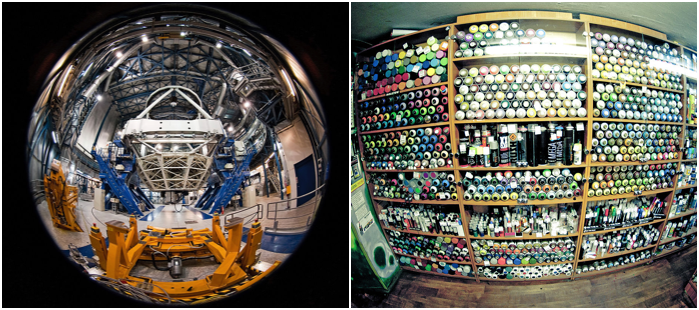
Some Fisheye Lens Recommendations
Due to their huge field of view, fisheye lenses are usually found in action cams (e.g. GoPro cameras). Relatively cheap fisheye lenses are also available for iPhone and other camera phones (e.g. the Olloclip 4-in-1 set). And all the major camera lens manufacturers, such as Canon, Nikon, Olympus, Sigma, Sony, Samyang, etc., have a fisheye lens available in their catalog.
Finally, fisheye lenses come in all sorts of prices. From the $950, pro-grade Olympus M.Zuiko Digital ED 8mm f/1.8 Fisheye PRO lens all the way down to the much cheaper, but fully manual, Samyang / Rokinon / Bower fisheye lenses.
I own the fully manual Samyang 7.5mm f/3.5 UMC Fisheye lens for my Olympus micro 4/3 camera and it is a joy to use. If you are tempted to get a fisheye but don’t want to spend too much on it, do not be afraid to go fully manual. Thanks to the very large depth of field, manual focusing is actually quite a pain-free process.
[Note: ExpertPhotography is supported by readers. Product links on ExpertPhotography are referral links. If you use one of these and buy something, we make a little bit of money. Need more info? See how it all works here. — Ed.]
Fisheye Lenses and Optical Distortions
Fisheye lenses, together with rectilinear wide-angle lenses, have a focal length less or equal to 24mm (equivalent to full-frame sensor size). This means they fall into the ultra wide-angle lens category.
Rectilinear wide-angle lenses are built in such a way that straight lines in the scene will be rendered straight (uncurved) in most parts of the image, with increasing amounts of distortion towards the edges of the frame.
In general, the shorter the focal length, the more difficult it is to rectify the lens. Fisheye lenses always manifest a strong curvilinear barrel distortion, as shown in the image below.
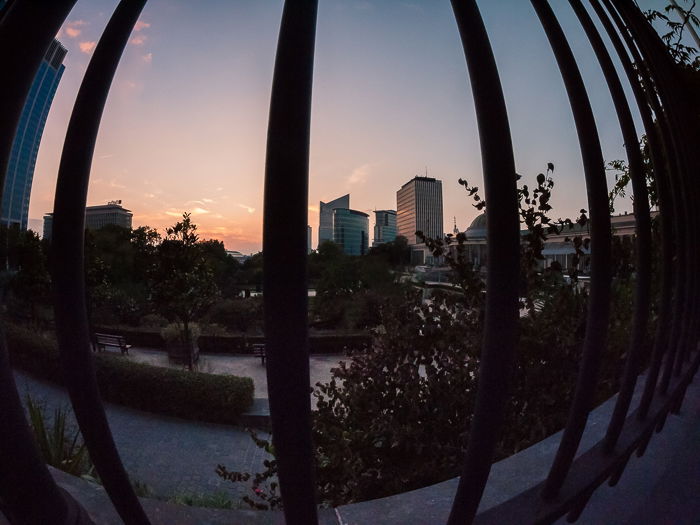
Many people do not like the fisheye effect because they do not like the resulting distortion in the images. In some cases, you can use post-process methods, such as defishing techniques using Lightroom or more specific software (e.g. IMADIO Fisheye-Hemi), to lessen the amount of distortion, or remove it altogether.
In general, though, careful composition and choice of subject can greatly reduce the visual impact of the fisheye distortion without the need for extra editing, particularly with full-frame fisheye.
So, how does a fisheye lens work in practice? All you need to remember to start doing serious fisheye photography is:
- The central part of the frame is less affected by the distortions
- The more you close in on your subject, the larger the distortion in the resulting image will be
- If you want a flat horizon, place it in the middle of your frame, and crop the photo later on to satisfy composition rules, such as the rule of thirds
- Tilt the lens upward to achieve a concave horizon
- Tilt the lens downward for a convex horizon
What Are Fisheye Lenses Good For?
In general, fisheye lenses are great travelling lenses for your camera. Because they are generally fast and you can easily use them indoors, they are great for taking photographs in museums, churches, and monuments.
They are equally good lenses for walking around the city. Fisheye lenses allow you to emphasise the height of buildings and monuments, as well as capture wide birds-eye views looking down at the city from high vantage points.
If you like the natural landscape, fisheye lenses are perfect for capturing wide panoramic views and also to photograph nocturnal landscapes and the Milky Way in all its glory.
One thing’s for sure—because they are quite different from any other kind of lens, if you are stuck in a photographic rut, fisheye photography is a great way to get your creative spark back.
Let’s take a look at a few subjects you can photograph with a fisheye lens, and how to get some strong effects.
Fun and Weird Images
The most straightforward way you can use a fisheye lens is to create funny and weird-looking images. Try to use the fisheye distortions when photographing a pet’s nose from up close, as with the dog in the image below. Big nose and begging eyes, teeny tiny body, great fun.
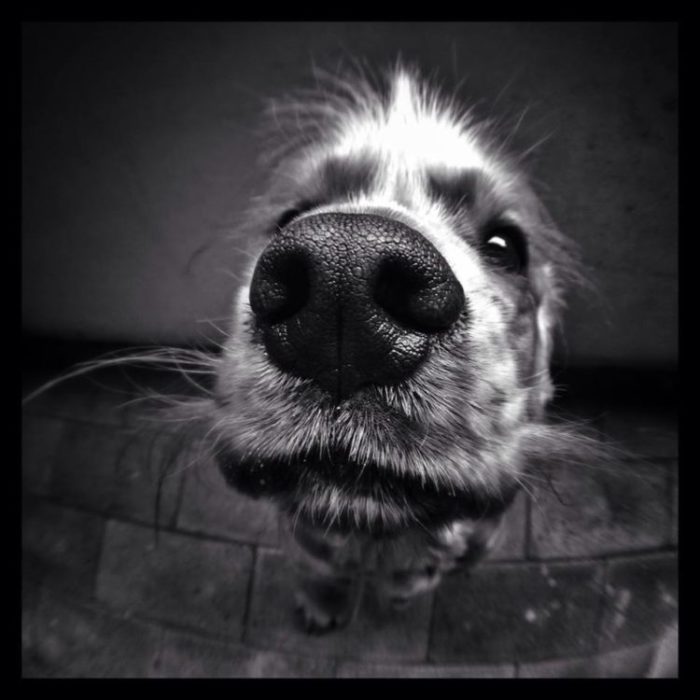
You can also tilt the camera upward or downward and rotate it to create funny landscapes from your otherwise unremarkable city park.
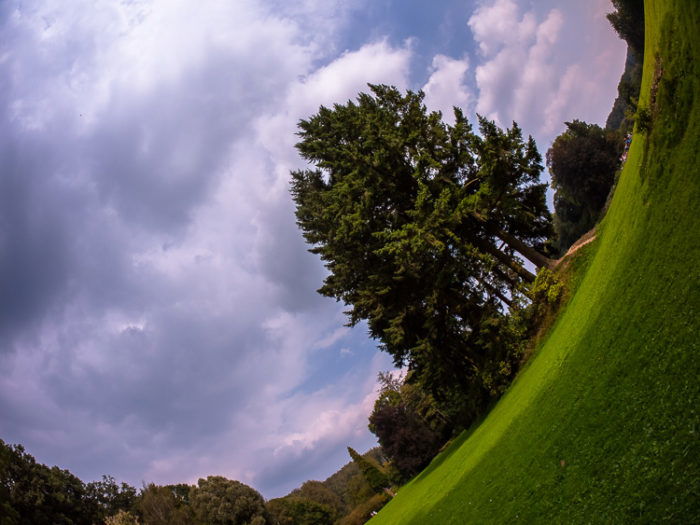
Finally, you can take advantage of the huge field of view and place your camera in small, secluded spots.
What about a selfie from deep inside your washing machine?
Just make sure the place is dry and remove your camera before washing
your clothes.
Note how, in the photo below, I managed to place myself towards the centre of the frame, thus avoiding strong distortions on my face.
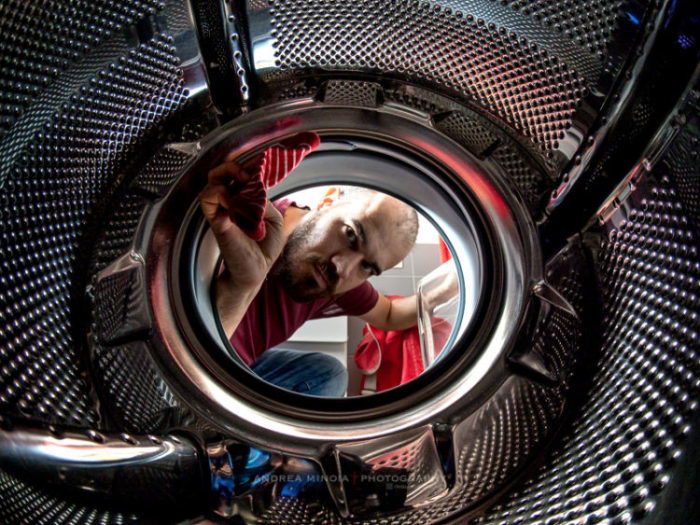
Portraits
Usually people will not be flattered by having you taking their
portrait with a fisheye lens—the nose will be too big, while the ears
and body will be too small. In short, you will mess up the typical
proportions of the face, particularly if you go for a headshot or for
close-ups.
But, in toddlers and very young children, face proportions are still
quite different from those of the average adult. Kids of this age have
small noses and huge, beautiful eyes in contrast to the rest of their
faces.
With a fisheye lens you can enhance these youthful proportions by making
the toddlers’ eyes even larger, particularly if shot in close quarters,
like from just beneath a car seat canopy.
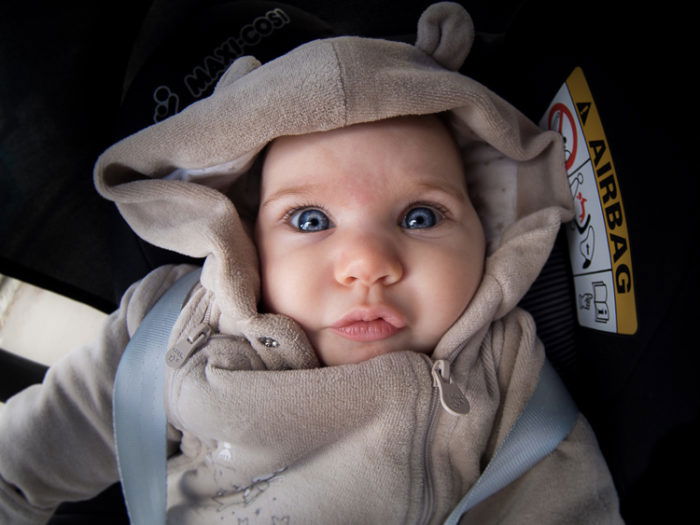
Natural Landscapes
Of all subjects, perhaps the one that suits a fisheye lens best is a
natural landscape. This is generally because landscapes have no straight
lines in them. And if you place the horizon in the middle of the frame,
it can go unnoticed that you have used a fisheye lens.
This is a great way to avoid buying a wide-angle lens, particularly if you rarely shoot wide.
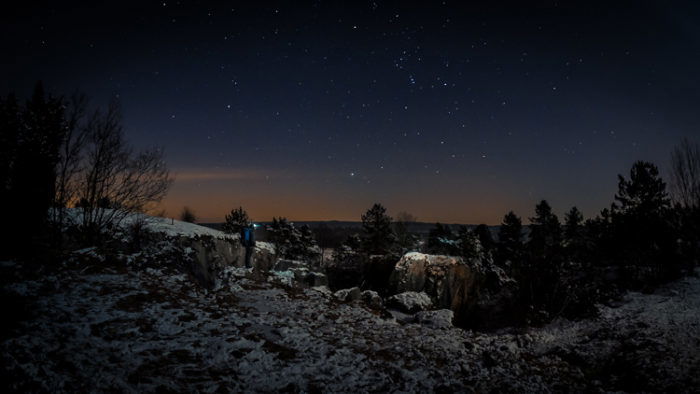
Fisheye lenses typically have a fast aperture, useful if you want to capture a large portion of the Milky Way while having a strong foreground with a large and interesting subject, like this small tree lost in tall grass shown in the photo below.

Sometimes, it is nice to have a curved horizon in a landscape, in order to create stronger lines that will lead the viewer toward the subject, as in this morning shot taken at the castle of Bornem, in Belgium.
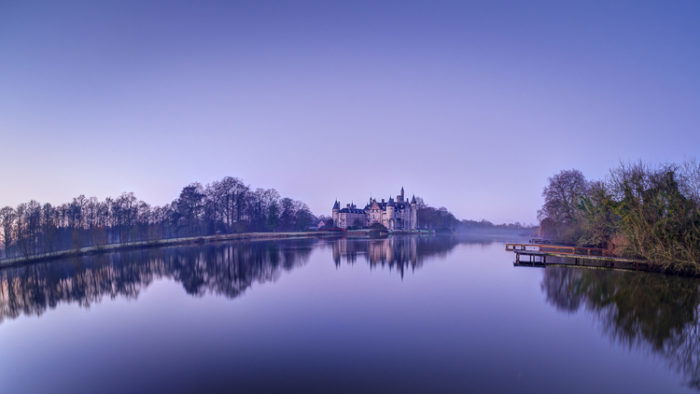
Fisheye and the City
As I said before, if you are a fan of urban environments, you should get a fisheye lens to capture monuments and tall buildings. For instance, the Atomium is a world-famous monument in Brussels. It also happens to be 102m tall.
To capture it entirely at 24mm (equivalent to full-frame), you have to move back about 80m from it. With my fisheye I was able to get it all into the frame from 15-20m away. The distortions helped create an original image of this famous location.
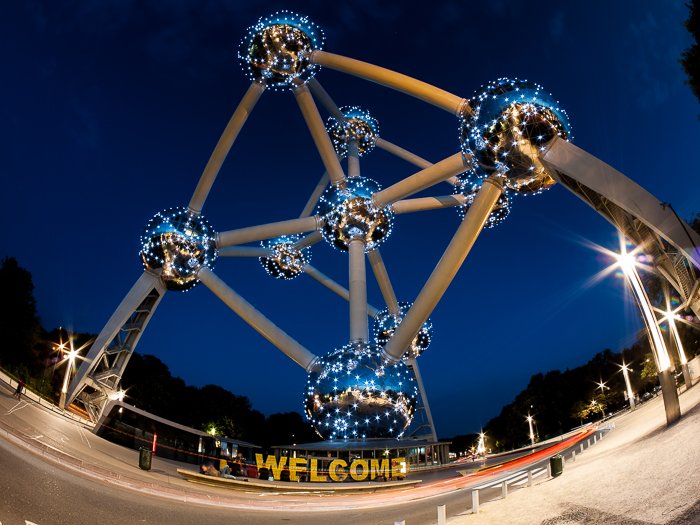
Another nice way to play with tall buildings is to use the distortions to make them bend around the image as if they were huge waves about to break.
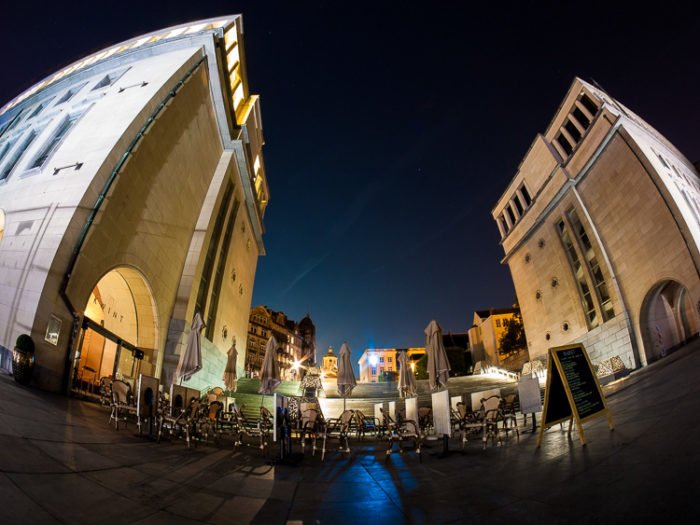
You should also take advantage of curved lines and amplify them to create strong leading lines, like this circular platform roof in front of Brussels Central Station.
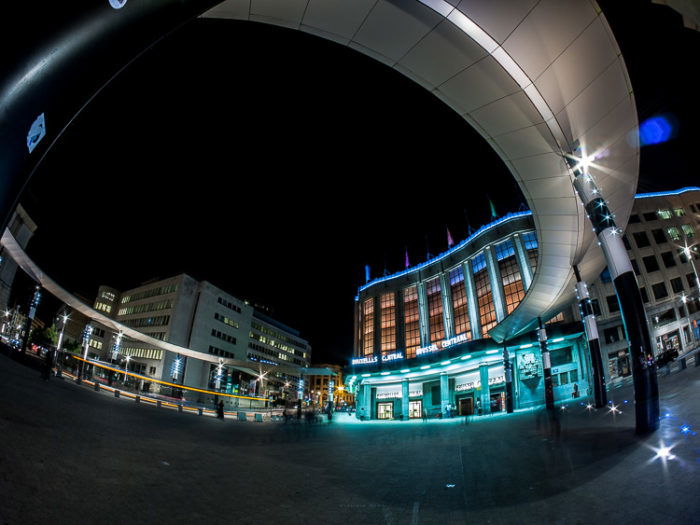
Finally, everybody shooting in the city has tried the classic photo
with night traffic light trails. Usually those trails are straight or
snaking into the distance following the road.
With a fisheye you can get a full roundabout into the frame and have
some space left to get circular trails. This creates a nice ‘traffic
light carousel’.
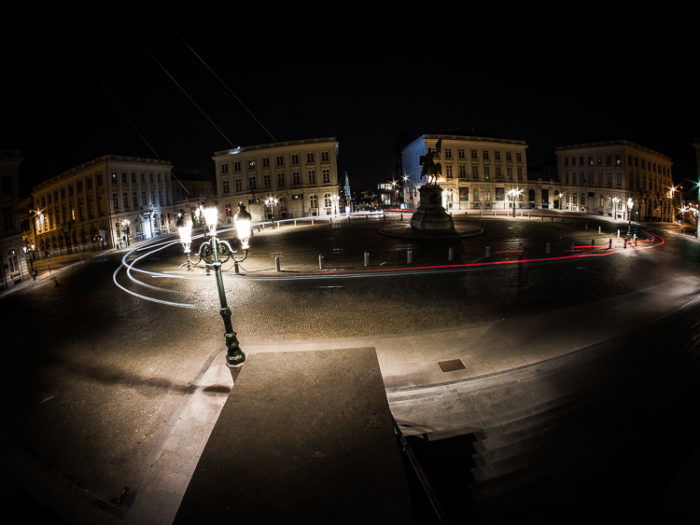
Before moving on to another subject, I would like to point out that I didn’t find lens flares to be an issue, as these nocturnal cityscapes (with their many street lights and other artificial light sources) show.
Interiors
You can do indoor photography with a fisheye and easily get everything into a single image. I took this picture of a gallery in Brussels, which has some nice interior architecture.
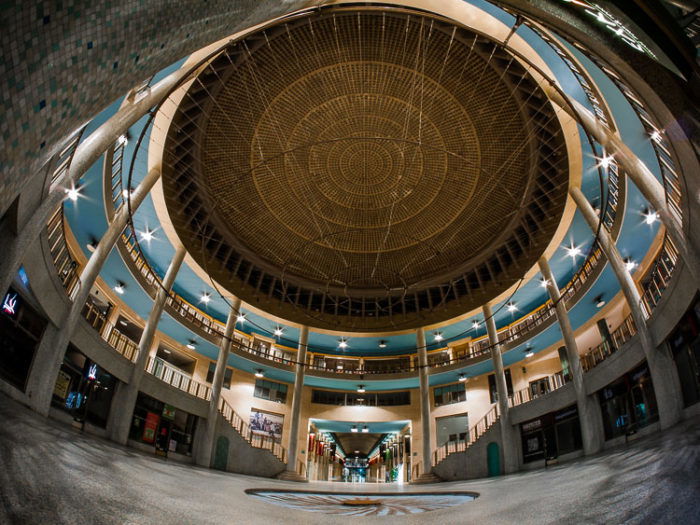
Bird’s-Eye Perspectives
It sounds funny to say, but you can get some great bird’s-eye views
with a fisheye lens. If you have access to a high vantage point, you can
have a nice panoramic view over the city.
I’m lucky to live in a tall building on top of a hill in Brussels. As
such, I found myself climbing to the building roof quite often with my
fisheye to take photos.
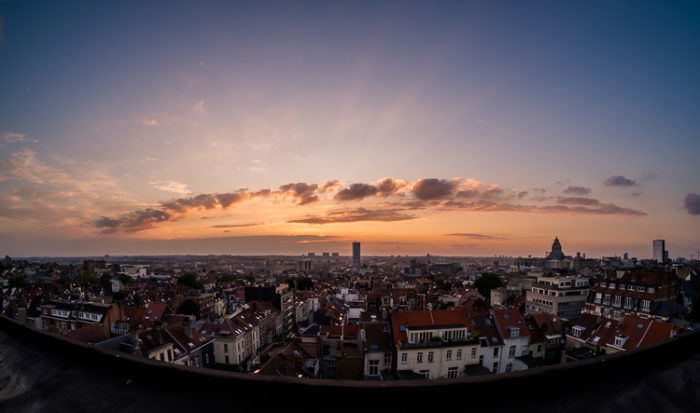
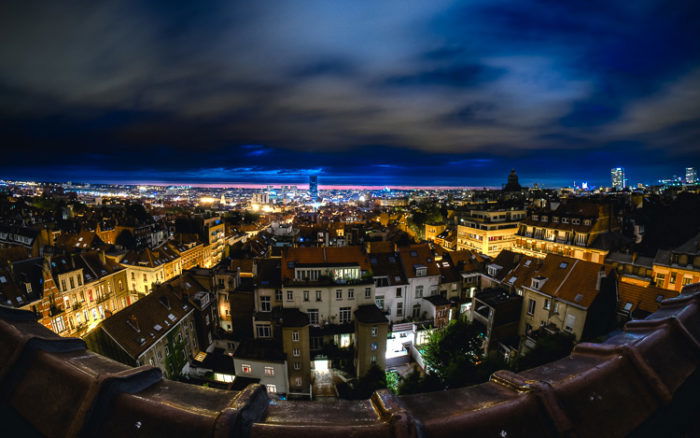
Need More Ideas?
Sports cars and motorbikes, as well as airplanes are great subjects for fisheye photography, provided that you can shoot from up close. People doing sports, like skaters in a skate park, also make for interesting subjects.
The real limit in using a fisheye lens, though, is your creativity and willingness to explore different possibilities.
Are you into street photography? With a bit of luck you can do it even with a fisheye lens. I managed to get a lucky shot of a praying man in the hall of the Justice Palace in Brussels at night.
The great merit of the fisheye lens in this photo lies in the way it highlights how huge the Justice Palace hall really is, compared with the praying man in front of the large door. The lens’s distortion make it seem as though his surroundings are stretching to dominate the space above him.
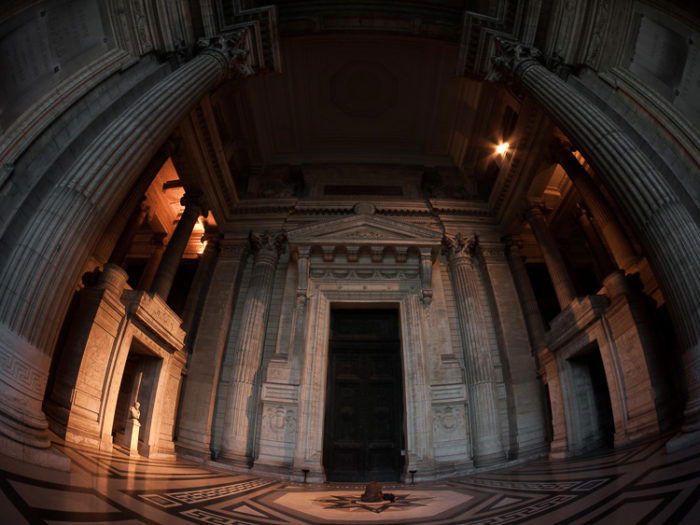
The Major Drawback in Fisheye Lens Photography: No Filters
Working with fisheye lenses is not great if you are addicted to photographic filters. As far as I know, no fisheye lenses can mount standard filters. This is due to the bulging front element of the lens. But you may find some custom made or DIY solutions.
Below, you can see an example of why you may need to use a filter with a fisheye lens.
I took this photo from the top of the Bayon waterfall in Belgium.
The use of a fisheye lens provides a nice, dynamic view of the area. I could combine many interesting elements, such as the water rushing down the waterfall, the colourful foliage, and the streaky clouds in the sky beyond.
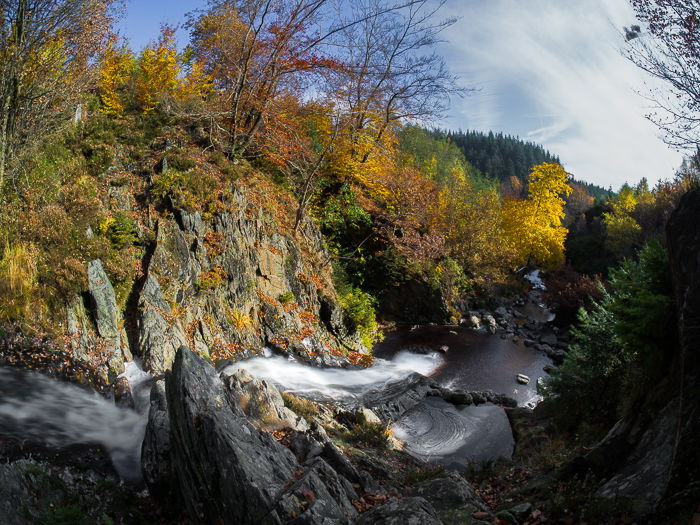
I wanted to have a scene that was dynamic, colourful, and large
enough to capture the grandeur of the place. From where I was standing, I
had to use my Samyang 7.5mm fisheye lens to do this.
I also wanted to incorporate the nice, silky look of motion-blurred water over rocks, which meant I had to take a long exposure.
How to Deal with the Problem: Two Workarounds
Placing a handheld filter in front of the lens may work with GND filters but for long exposures this is a ‘no go’. Light leakage will be unavoidable.
As mentioned earlier, because these wide-angle lenses have the front element bulging out, some, such as the Canon EF 11-24 f/4L USM, have a rear slot for gelatin filters. Some people have taken to taping small pieces from ND gelatin filters to the rear element of a fisheye lens.
-------------------------------------------------------------------------------------------
Another FREE Photography Ebook
A focal point is one of the more straightforward composition concepts for a photographer to grab onto.
However, many photographers don’t really understand what a focal point is and, more importantly, how it works to their advantage.
A focal point is most simply defined as the point of interest in an image and the area that is the center of attraction for a viewer. In the fine arts, the focal point is referred to as the point of interest that makes an artwork unique. This is an exciting concept to carry over to photography.
When you choose your focal point, you’re essentially telling a viewer where you want them to look.
Keep in mind that there are essential steps in the use of a focal point.
In this guide, Jo Plumridge provides you with an introductory lesson on focal points in photography.

No comments:
Post a Comment
Note: Only a member of this blog may post a comment.